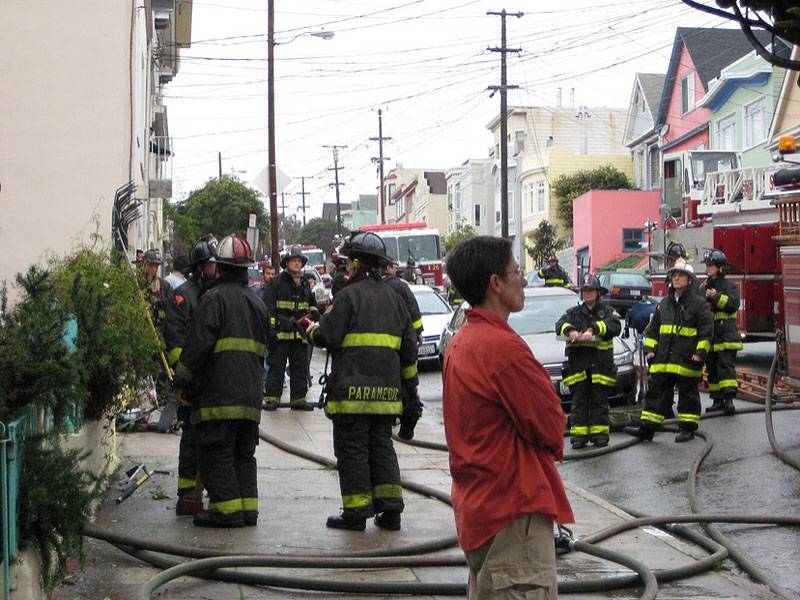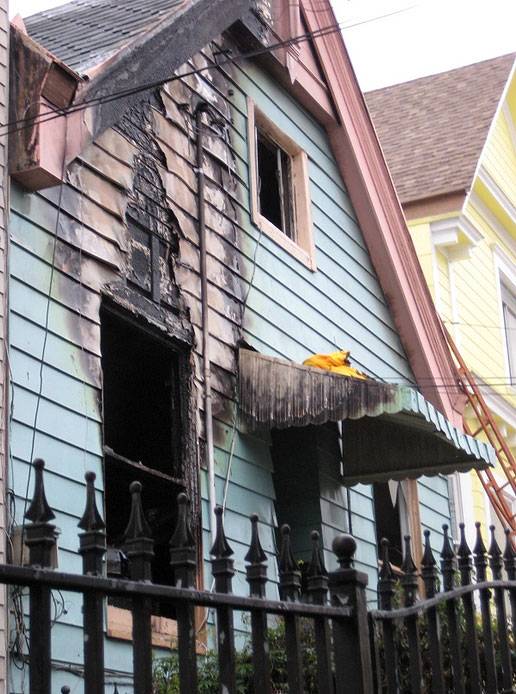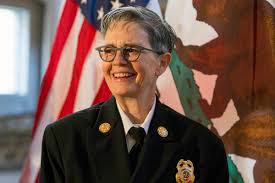Why I Hate Firemen: Difference between revisions
No edit summary |
No edit summary |
||
| Line 1: | Line 1: | ||
'''<font face = Papyrus> <font color = maroon> <font size = 4>I | '''<font face = Papyrus> <font color = maroon> <font size = 4>I was there . . .</font></font> </font>''' | ||
''by Molly Martin'' | ''by Molly Martin'' | ||
| Line 105: | Line 105: | ||
[[category:Women]] [[category:2000s]] [[category:2010s]] [[category:Bernal Heights]] [[category:racism]] | [[category:Women]] [[category:2000s]] [[category:2010s]] [[category:Bernal Heights]] [[category:racism]] [[category:LGBTQI]] [[category:Public Health]] | ||
Revision as of 22:29, 1 April 2020
I was there . . .
by Molly Martin
Originally published on tradeswomn musings, December 2019.
Sitting in my favorite chair in the living room of my newly remodeled condo, I heard the violent breaking of glass. It sounded like someone was throwing bottles on the sidewalk with great force. I couldn’t see anything out the front window so I put on shoes and went out there. That’s when I saw flames shooting from the next-door neighbor’s window, broken by the intense heat.
Molly outside the fire scene.
Photo: courtesy Molly Martin
The year was was 2009. After nearly a decade of work restoring and remodeling the three-unit building where I lived for 38 years in San Francisco, it nearly burned down that day.
I had brought my cell phone and immediately called 911. Someone had already called and the fire department said a truck was on the way. It seemed like it took forever but later I learned it had taken two minutes to come from our neighborhood firehouse at Holly Park.
A woman in a bathrobe emerged at a run from the ground level of the house next door. She had been in the shower when she smelled smoke. We knew that many people lived in the house. The owners of the single-family dwelling had divided it up into plywood cells with doors and locks, which they rented to Chinese immigrants, most of whom spoke no English. We had no idea how many people might be in the building.
After rehab, my house on the left.
Photo: Molly Martin
I should add at this point that I hate firemen. Not firewomen, only the men. And not the firemen of color. Only the white men.
Whenever we have occasion to honor firefighters, which is lately often as the West has been burning up every year, I stand back and think to myself, I hate these mofos.
When I tell anyone I hate firemen, the reaction is always shock. “But there are some good men.” And to this I say yes I know but they’ve gotta prove it to me, just as I had to constantly prove to my male coworkers over and over at work in construction that all women are not stupid and weak. In the meantime I’m sticking with my prejudice, formed by years of interaction with woman-hating racists in the San Francisco Fire Department. I may never get over it.
My hatred has roots in the decades-long fight to integrate women and people of color into the department, formed by listening to the stories of female firefighters who had to live in the firehouses where they were hated, denigrated, physically attacked and whose lives were in danger from the men they worked with.
The idea that firefighters are heroes to be worshipped not only had an unfortunate effect on the culture at the firehouses, inflating already overinflated egos. It also made opposing the white men more difficult. They used the positive stereotype to their advantage, calling on the testimony of citizens whose lives and property had been saved.
Before women fought their way in to the SFFD, men of color experienced a racist culture and lack of safety in the department. The first black firefighter entered the department in 1955 as the result of a lawsuit. The San Francisco fire fighters union, local 798, and its international affiliate, possibly the most racist union in the country, waged a campaign to keep minorities and women out of the department. Once they got in, the union and the white men did whatever they could to make their lives miserable. Swastikas, confederate flags, death threats, excrement in boots, tampering with safety equipment, discriminatory entrance exams were some of the tactics. Robert Demmons, a black firefighter, sued the department for discrimination and the lawsuit later included women and other men of color as plaintiffs.
Chief Bob Demmons
Although agitation to include women in these well-paid jobs began in the 1970s, the first women did not enter the department until 1987. In the lawsuit, women were lucky to draw a judge who saw that breaking the gender barrier required strong measures. In 1986 US District Court Judge Marilyn Patel issued a consent decree requiring the department to hire ten percent women. The SFFD resisted the decree but they had to comply. The ten percent goal for women was met in 1997 and the decree lifted.
The person who files the lawsuit, whether in the trades or other professions, usually ends up dead or blacklisted, a martyr to the cause. Bob Demmons, who became president of the Black Firefighters Association, went to work every day thinking he might be killed. Several attempts were made on his life. We affirmative action activists thought Bob would end up as our martyr, but instead he was appointed chief of the department in 1996 by Mayor Willie Brown. The department was still a mess and Bob worked closely with women and other men of color to change the culture. He knew he would have only a short time before the union and racists got him removed and he moved as quickly as he could to bring in and promote more women and minorities. I think Bob did more than any other individual to make firefighter jobs available to women. He’s my hero.
We women did have a martyr, Anne Young, one of the first four women to be hired as firefighters, the first lesbian and also the first female lieutenant. Anne became the public face of women and so she endured the worst harassment.
I first met Anne at the Women’s Training Center gym in San Francisco where we both worked out. An electrician, I was involved in the fight for affirmative action, agitating to get women into the construction trades and other male-dominated jobs. She was 18 and already clear about her life goal. She was training to be a firefighter. Anne took entry exams at fire departments all around California and she landed a job at the Daly City fire department where she did well. But Daly City is small, with very few fires and emergencies. She set her sights on the big city of San Francisco.
Anne was smart and strong and she already had experience working as a firefighter. She easily passed the entrance exam and became one of the first women to enter fire college. Harassment started immediately. The day that the first women graduated, before they even started working as firefighters, white men were picketing out in the street, saying that women had taken jobs from them.
Bob Demmons and Anne Young began to collaborate. They both wanted a department that reflects the percentages of population that it serves, that could speak all its languages, that would have women helping women. By that time most of the calls were medical emergencies, not fires.
At the time women first got in, San Francisco’s 41 firehouses operated like a fraternity house row. Pornography was everywhere. Men watched porn on TV in the firehouses, which were scenes of hours-long cocktail parties and drinking contests. Bob showed Anne the granite wall with all the names of the firefighters killed in the line of duty. He pointed out names: “He was drunk, he was drunk, he was drunk.” They were dead because they were drunk at a fire.
Female firefighters constantly had to choose. Did you go along with the culture and drink with the boys, or follow the rules which disallowed drinking, and risk isolation? One woman drank with the boys and passed out at dinner. She was terminated, and the female firefighters support group failed to offer any support. They didn’t want to be associated with her.
Many women took the entrance tests and failed to pass. Many were terminated while on probation. One woman who made it in later committed suicide. The ones who stayed tried to be invisible, to not buck the culture. The other women in the SFFD did not necessarily support Anne.
As in construction, I don’t fault women for how they choose to survive. We’ve developed many survival strategies. You have a choice of joining the culture or objecting. The women who tried to be invisible and didn’t stick their necks out, who put up with the harassment or tried to be one of the guys, generally survived. Anne felt she couldn’t go along to get along. She felt pressure to make a choice every single day at work to represent every woman, represent every queer.
In the 1990s, before public shaming on the internet took hold, white male firefighters and retirees attacked females and minorities in a publication called the Smoke Eaters Gazette. They actually put in writing their horrible lies and distributed the paper to everyone in the department. We never learned who wrote and mimeographed it.
Anne was a union member, but when she found out the union was using her dues money to oppose affirmative action, she resigned from local 798 and joined the Black Firefighters Association, a slap in the face to the union and the white men.
A watershed moment came in 1988 when the women in the SFFD and Black Firefighters Association drove a fire truck in the gay parade, a first for the department, known for its homophobic culture. Anne Young was driving the truck. Cheers went up from the crowd. The black firefighters stood with the gay community politically in that moment. It took some courage for the straight black men to march in the parade. I was watching from the street and I cried. People on the sidelines were yelling, “Hey-hey, ho-ho, racism has got to go.” The guys were crying. Everyone was crying. It was an historic event.
Anne did well on tests. She had taken and passed many. When the lieutenants’ test came up she was urged to take it by the lawyers and the BFA (the consent decree was still in force). The chief of the department called her in to his office and told her she could have anything she wanted if she didn’t take the test.
In retrospect, she said, taking the lieutenants test and promoting was a mistake, the beginning of the end of her career. As a new lieutenant she worked a different firehouse every day. Some days the entire crew would call in sick, sending a clear message they didn’t want to work for her. Death threats were common. But when men on her crew tried to throw her off a roof, that was her breaking point. They could have gotten away with her murder. Firefighters fall off roofs. No one would have known she was pushed.
After that, Anne kept going to work, but she felt she could no longer do her job competently.
I’ve seen this happen to other women in male-dominated jobs when the everyday level of stress becomes too much for the body to bear. Your mind tells you to go to work but at some point your body rebels. You get sick or injured and you can no longer go to work. After she was nearly killed, Anne had what she called a nervous breakdown. One day she just couldn’t get out of bed. I think this was her body protecting her from harm.
Anne filed a lawsuit and there was a trial where she was called upon to paint the SFFD with a broad brush of discriminatory treatment. She didn’t get to talk about how much she loved the job, working with a team, saving lives. It had been her dream and she was really good at her job. She wasn’t able to focus on the good men who helped her. But, on the whole, even the good guys had refused to stand up for her and risk retaliation from the bad actors. They enabled the harassers.
Three years after filing suit, in 1995, Anne won the lawsuit and was awarded $300,000. But her career as a firefighter was finished. She lost her income, she lost her house. Trauma had infected her like a disease.
I thought of this history as I stood on the sidewalk and watched the house next door to mine burn. When the first fire truck arrived at the scene, the first firefighter who jumped off was a woman I recognized, Nicol Juratavac. She was working as a lieutenant that day. Among the firefighters were several women and men of color. One, a Chinese man, was the only person able to communicate with the next door building’s residents. Then a car pulled up with another woman I recognized, Denise Newman. She was working that day as a battalion chief. Of course, by that time in 2009 the chief of the department was a female, Joanne Hayes-White, appointed by Mayor Newsom in 2004.
SFFD Chief Joanne Hayes-White (L) SFPD Chief Heather Fong (R)
Along with a congregation of feminist activists, I had shown up at city hall the day her appointment was announced. Newsom appointed a female police chief as well, which gave us all high hopes that the asshole culture could be turned around. And I do think some progress was made. Hayes-White stayed on the job for 15 years, long after Newsom had moved on up the political ladder. The SFFD women often clashed with her, but in general her policies and promotions were female friendly. Heather Fong, the police chief, hung in for ten years before the white men and the police union were finally able to run her out.
Wringing my hands and worrying that my newly remodeled building was about to go up in flames, I was grateful for the SFFD. And I had an epiphany: decades of fighting to make the department reflect San Francisco’s diverse population had paid off. The fire department had been integrated.
Now, a decade later, many of those first women have retired from the department with generous pensions. Some of them struggle with PTSD from years of harassment. Yes, the culture in the firehouses has changed for the better, but discrimination and harassment are still present. Anti-affirmative action laws passed in the 1990s make targeted recruitment illegal and make it difficult for California public safety entities to maintain the minimum number of women and minority employees that had been required by SFFD’s consent decree. There’s no guarantee that the department will not revert back to its old white male culture.
SFFD Chief Jeanine Nicholson
However, the new chief of the department, appointed in 2019, Jeanine Nicholson, a lesbian cancer survivor and also burn survivor, gives me hope that the department has changed for good. Still, I haven’t forgiven those white men.
I thank Bob Demmons, and especially Anne Young who sacrificed her career so other women could become firefighters. They were truly change makers.







